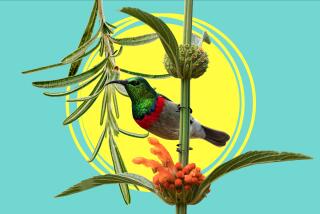TO TELL THE TRUTH : Will the Real Dusty Miller Please Stand Up?
- Share via
Confused about dusty millers? You are not alone; many gardeners are perplexed by these ornamental shrubs with gray-to-silvery foliage. This is understandable: Commercial growers label three totally different plants, and a host of their varieties, as dusty millers. The fact that one grows less than a foot tall and another soars to three feet makes buying these plants something of a gamble--or a surprise, if you happen to like that sort of thing.
Silvery-leafed plants are prized by astute gardeners because they help separate and pacify strong colors. And their felt-like leaves remain attractive long after annual and perennial flowers have ceased blooming. Although most dusty millers are perennials, they’re treated as annuals and are often replanted every year because they grow so fast.
To help you sort out one from the other, here’s a guide to the three groups of dusty millers commonly available as bedding plants in Southern California.
The centaurea dusty millers. Often sold as standard dusty miller, Centaurea cineraria ( C. candidissima ) is the most widely grown. This compact perennial, which reaches a height of 12 to 14 inches, retains its neat appearance in the garden for about two years, after which it generally becomes tattered-looking and should be replaced. Snails are attracted to Centaurea cineraria , so take precautions.
As a mature plant, Centaurea cineraria can be recognized by its dense basal clump of strap-like lobed leaves and by its globular, one-inch yellow flowers on 18-inch stalks. Unlikely as it may sound, this particular dusty miller is closely related to the annuals bachelor’s button ( Centaurea cyanus ) and sweet sultan ( C. moschata ). Plants are classified by their flowers, and floral parts on these three diverse plants are nearly the same. Although experts agree on the genus for Centaurea cineraria , they do not agree on its species. Most classify it C. cineraria , others call it C. rutifolia , and still others consider it to be C. ragusina. In the trade, however, it’s known simply as the centaurea dusty miller.
The senecio dusty millers. With the botanical name Senecio cineraria maritima , the senecio dusty millers (called cineraria dusty millers in the trade) have downy, white leaves and range in height from nine inches to three feet. Unlike the centaurea dusty millers, they can be revitalized if they’re cut back in the fall. Most senecio dusty millers produce clusters of yellow ray flowers.
This family of old-fashioned perennials has gained the attention of hybridizers who are now turning out compact cultivars, such as the popular ‘Silverdust,’ which has finely serrated but thickly textured white leaves that look like sea coral. It’s said to reach only nine inches, and perhaps in climates with shorter growing seasons it remains compact. In our climate, though, it eventually attains two feet.
The older cultivar, ‘Diamond,’ sometimes sold as dwarf dusty miller, has oak-like leaves and, as a seedling, is often confused with Centaurea cineraria. Far from being a dwarf, ‘Diamond’ requires ruthless cutting back to keep it within bounds, especially if it’s grown in a semi-shady spot.
The ‘Silver Lace’ dusty millers. Chrysanthemum ptarmiciflorum , usually found as ‘Silver Lace,’ is still another dusty miller, but one with finely cut, wiry leaves that grows to a height of two feet. Its delicate, filmy appearance contrasts with the heavy, bulky look of the centaurea and senecio dusty millers. It also grows more rigidly upright than any of the others. Occasionally, you may see it labeled Pyrethrum ptarmiciflorum .
One thing that all dusty millers have in common is that they grow in full sun or partial shade, and once they get established, they’re moderately tolerant of drought.






